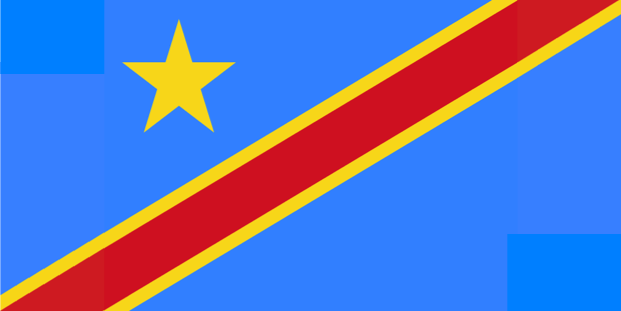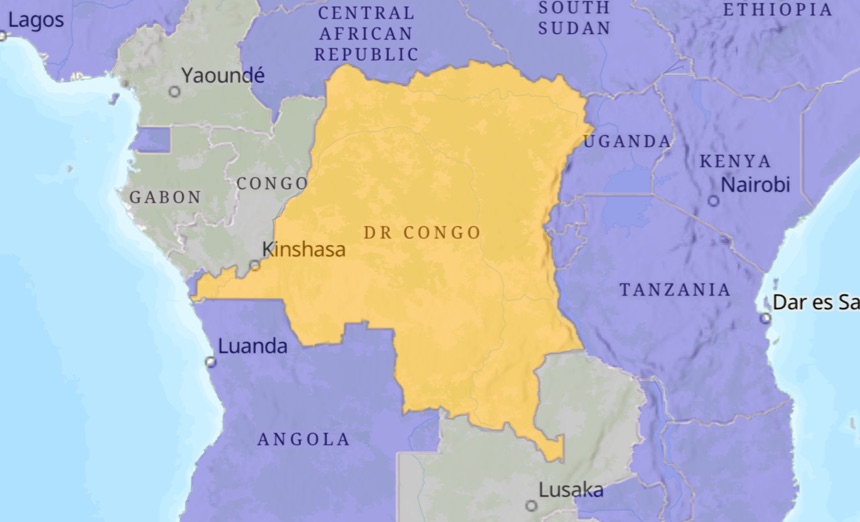Since gaining independence from Belgium in 1960, the Democratic Republic of the Congo (DRC) has experienced significant political turmoil. The resurgence of armed conflict in 1996 led to a proliferation of small arms and light weapons and ammunition.1 Intense fighting between government forces and non-state actors continues, mostly in the eastern region; with the support of the UN Organization Stabilization Mission in the Democratic Republic of the Congo (MONUSCO), the country is engaged in several non-international conflicts against armed groups in Kivu, Kasai and Ituri.2 This armed violence is fuelled by the illicit flow of small arms and light weapon and ammunition across the country's borders, which has resulted in population displacement and had devastating health and economic impacts in the DRC.3
The country's guiding gun control legislation comprises the Law of 1985 on the Regime of Arms and Ammunition.4 In 2016, a national weapons and ammunition management baseline assessment was implemented by the government, in cooperation with UN Institute for Disarmament Research (UNIDIR) and the UN Mine Action Service (UNMAS). In addition, MONUSCO; the Mines Advisory Group (MAG); and the Regional Centre on Small Arms in the Great Lakes Region, the Horn of Africa and Bordering States (RECSA) have supported various ammunition management programmes in the country, including on ammunition destruction and stockpiles security.5
1 UNMAS (UN Mine Action Service) DRC, "Improving Security in the DRC through Weapons and Ammunition Management," The Journal of Conventional Weapons Destruction (2020), https://commons.lib.jmu.edu/cgi/viewcontent.cgi?article=2916&context=cisr-journal.
2 "DRC: A Mapping of Non-International Armed Conflicts in Kivu, Kasai and Ituri,” Rule of Law in Armed Conflicts Project (RULAC), Geneva Academy of International Humanitarian Law and Human Rights, updated February 5, 2019, https://www.rulac.org/news/democratic-republic-of-the-congo-a-mapping-of-non-international-armed-confl.
3 Bureau of Political-Military Affairs, US Department of State, To Walk the Earth in Safety (Washington, DC: US Department of State, 2018), https://www.state.gov/reports/to-walk-the-earth-in-safety-2018/.
4 Philip Alpers, Michael Picard and Clara Mourlevat, Congo (DRC) – Gun Facts, Figures and the Law (GunPolicy.org, Sydney School of Public Health, University of Sydney, 2022), https://www.gunpolicy.org/firearms/region/congo-drc.
5 “Ammunition Management Activity Platform (A-MAP),” GICHD, 2022, https://a-map.gichd.org.
Launch the country dashboard
Further information
Accidental explosions
Since the Small Arms Survey began collecting data in 1979, nine accidental explosions have been reported in the DRC.
Table 1. Accidental explosions in the DRC (1979–2021)
Year | Location | Owner/manager | Deaths | Injuries |
2014 | Mbujy Mayi | State (military) | 21 | 54 |
2011 | Kibomango | State (military) | N/A | N/A |
2011 | Lubumbashi | N/A | N/A | N/A |
2010 | Mbandaka | State (military) | 0 | 0 |
2009 | Goma | N/A | N/A | 1 |
2009 | Kananga | N/A | N/A | N/A |
2007 | Mbandaka | State (military) | 3 | 52 |
2005 | Walikale | State (military) | 6 | 0 |
2000 | Kinshasa | State (military) | 101 | 200 |
Source: “Unplanned Explosions at Munitions Sites (UEMS) Database,” Small Arms Survey, updated December 15, 2021, https://smallarmssurvey.org/database/unplanned-explosions-munitions-sites-uems.
Cases of diversion
Since 1996, there have been numerous cases of diversion of arms and ammunition from government stocks to armed groups.
Source: "Final Report of the Group of Experts on the Democratic Republic of the Congo," UN Security Council, January 12, 2015, https://reliefweb.int/report/democratic-republic-congo/final-report-group-experts-democratic-republic-congo-s201519.
Disposal
To decrease the above-mentioned risks of accidental explosions and diversion, the Democratic Republic of the Congo disposes of its ammunition.
Table 2. Disposal of tonnes of ammunition in the DRC
Year | Tonnes of ammunition |
2018 | 111 |
2013–14 | 75 |
2009–10 | 335 |
2006–09 | 335 |
Sources: "DR Congo: Destroying Surplus Arms, Reducing Danger," MAG, March 11, 2009, https://reliefweb.int/report/democratic-republic-congo/dr-congo-destroying-surplus-arms-reducing-danger; "DR Congo: 100,000 Weapons Destroyed," MAG, September 13, 2010, https://reliefweb.int/report/democratic-republic-congo/dr-congo-100000-weapons-destroyed; "Conventional Weapons Disposal by the Mines Advisory Group in the Democratic Republic of the Congo during FY14," Mapping ATT-Relevant Cooperation and Assistance Activities database, Stockholm International Peace Research Institute, 2014, https://att-assistance.org/activity/conventional-weapons-disposal-mines-advisory-group-democratic-republic-congo-during-fy14; Bureau of Political-Military Affairs, US Department of State, To Walk the Earth in Safety.
Needs
To further enhance safe and secure ammunition management, the following needs have been identified for the Democratic Republic of the Congo:
- Development or refinement of standards and procedures on stockpile management; and
- Capacity development for the destruction of surplus stockpiles.
Source: Democratic Republic of the Congo, National Report on the Implementation of the Programme of Action on Small Arms and Light Weapons (PoA) and the International Tracing Instrument (ITI) (New York: Permanent Mission of Democratic Republic of the Congo to the UN, 2022), https://unoda-poa.s3.amazonaws.com/reports/COD-French-1241-SUBMITTED.pdf.



